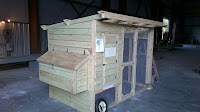I have 2 peach trees just off the raised bed garden. They
have never produced any viable fruit. Honestly, I think this breed is not meant
for this far north but even if they never give me a single, juicy peach, they
will always remind me of my childhood and my grandparents.
See, I have lost all of my grandparents at this point in my
life. I even had the honor of knowing 4 of my great grandparents, one into my
adult life. I don’t know how often that happens but I cherish the time I had
with each of them. My father’s side of the family were strong farmers. The
property my parents still live on was once part of 1000 acres given as dowry to
my great, great, great grandmother. It has been farmed since that time in one
way or another, over time being split up among the children of each generation.
My grandparents still had 475 acres, if memory serves, when I
was growing up. It was dotted with fields, gardens, orchards and ponds. Many
days were spent as a child with one or both of my grandparents walking or
riding over that property. The older I became, the more I helped at harvest
time, picking produce, shelling peas, helping as my grandmother canned or froze
different things, or throwing her kitchen scraps around her blueberry bushes.
But the best thing ever was fleeting and only available for a few weeks in the
summer.
One of the orchards was full of various breeds of peaches.
The best one was an Elberta tree. It produced what my memories store as a huge,
bowl filling peach. Juicy and flavorful. Best chilled in the fridge but just as
delicious fresh off the tree. Thanks to this tree, I will never have a peach
that even comes close to good from a store. In fact, I hate buying fresh
peaches. I do love peaches though, so when I am able to get some fresh from a
farm I enjoy them, but nothing will ever be as good as those memories.
At some point after I married and moved away my grandfather
had to do away with the orchard due to a blight of some sort. I was
heartbroken, but such is the life of a farmer. You grow what you can, but if
the land and the plants can’t produce, you have to change the equation somehow.
I was sentimental so I didn’t want to see it go. Time moved on and after they
both passed, my brother had the opportunity to obtain the family home.
Remember those kitchen scraps I would help throw out? Well, often they contained peach pits. While my grandparents were alive they would
keep any sprouts under control so it didn’t overtake the blueberry bushes. My
brother, knowing how sentimental I was about that orchard, saw a couple small
seedlings that he could transfer to a pot and give me for mother’s day several
years ago. No store bought gift could ever compare to that. I know they cannot
be from the same trees I picks peaches from in long sleeves in the hot, humid
mornings of July so long ago, but they came from those kitchen scraps of my
grandmothers.
I brought those seedlings home and proudly planted a piece
of my childhood home on the property of my adult home. Each year they have
gotten bigger and fuller. I have learned about pruning and how difficult it is
to organically care for peach trees. I have been excited as the blooms appear
in the spring and small green fruit a few weeks later. I have been disappointed
as all of it withers or falls off, poisoned by the eggs of some wasp that
reaches it in the bloom stage. But regardless, I love those trees, even if I
never get a peach because every time I see them I see my heritage and where I
came from. I see what I am capable of and where that strength comes from. I see
my family tree… all of it. Every branch making me who I am today.


















